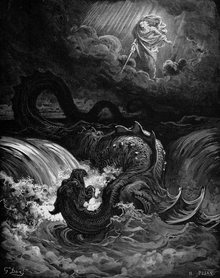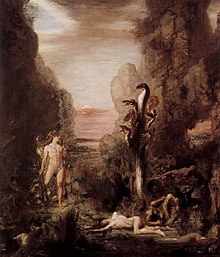Polycephaly
Polycephaly (from ancient Greek πολύ poly 'many' and κεφαλή kephali 'head'), German: "many-headed" or "multi-headed", generally denotes the appearance of several heads in living beings. If there are two heads, one speaks of dicephaly .

biology
While no cases of polycephaly are known in human medicine , there are individual reports from biology :
- Three-headed turtle
- Three headed frog
In the Bible
In the Old Testament :
In the New Testament :
- In the Revelation of John , the archangel Michael slays a dragon and defeats a monster with seven heads ( Rev 12 : 3 EU ).
mythology
Many-headed beings appear in the mythology of numerous cultures, which may be influenced by actual biological cases.
So many-headedness is a distinctive characteristic of Slavic deities . The gods of war Triglaw , Svantovit and Rugievit were represented with three, four and seven heads, respectively, Porenut also had four heads.

In Greek mythology, many monsters occur with multiple heads. The dog Orthos had two, the hellhound Cerberus three (according to individual stories more), the dragon Ladon two or three (sometimes even a hundred), the serpent Hydra nine and the monster Typhon finally a hundred. Hekatoncheiren also appear with “100 hands”. Also Scylla was sometimes described as a six-member sea monster.
In Sumerian mythology, there is a seven-headed serpent named Muš-sag-imin.
In Hinduism , too , Ganesha and Shiva are sometimes represented with multiple heads, or the demons Asura , Rakshasa , Ravana and Trishira .
Zahhak (Sohak) with three heads occurs in Iranian mythology.
Thrudgelmir (Þrúðgelmir), a six-headed giant, appears in Norse mythology .
Yamatanoorochi , the eight-headed serpent, is part of Japanese mythology
heraldry
Multiple heads also appear as a motif in heraldry, for example with the three-headed eagle .
literature
- Raffaele Pettazzoni: Many-eyed The all-knowing God , pp. 58-66, The all-knowing God
- Spider foot & toad belly. Genesis and symbolism of composite beings. In: P. Michel (Hrsg.): Writings on symbol research. Volume 16. PANO Verlag, 2013, ISBN 978-3-290-22021-1 , symbol research
Web links
Individual evidence
- ↑ Three-headed turtle destined not to go far. CNN.com, January 27, 1999, accessed December 31, 2006.
- ↑ Diagonal View. April 5, 2008
- ↑ O. Keel: The world of ancient oriental pictorial symbolism and the Old Testament. Using the example of the psalms. 5th edition, 1996, ISBN 978-3-525-53638-4
